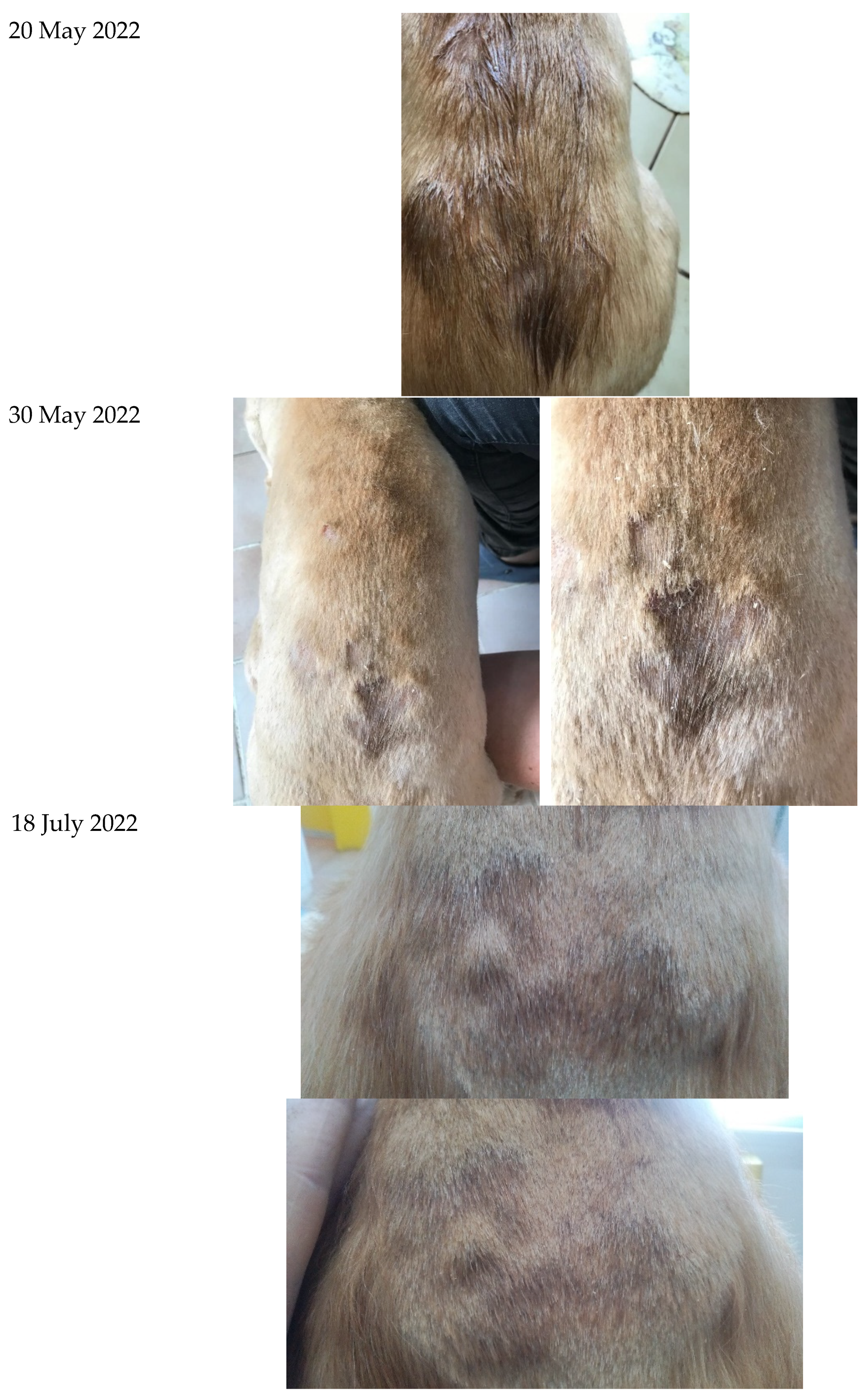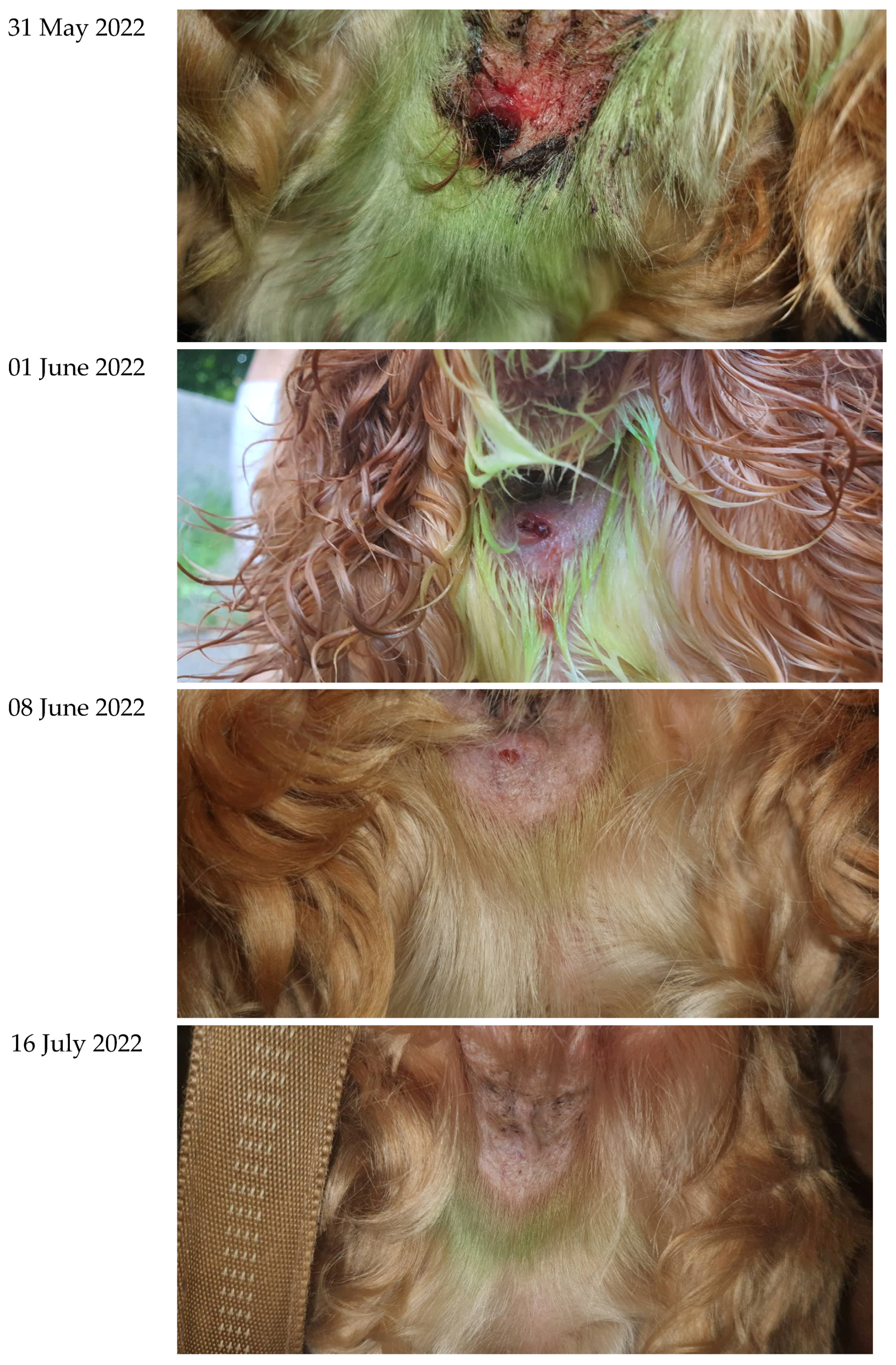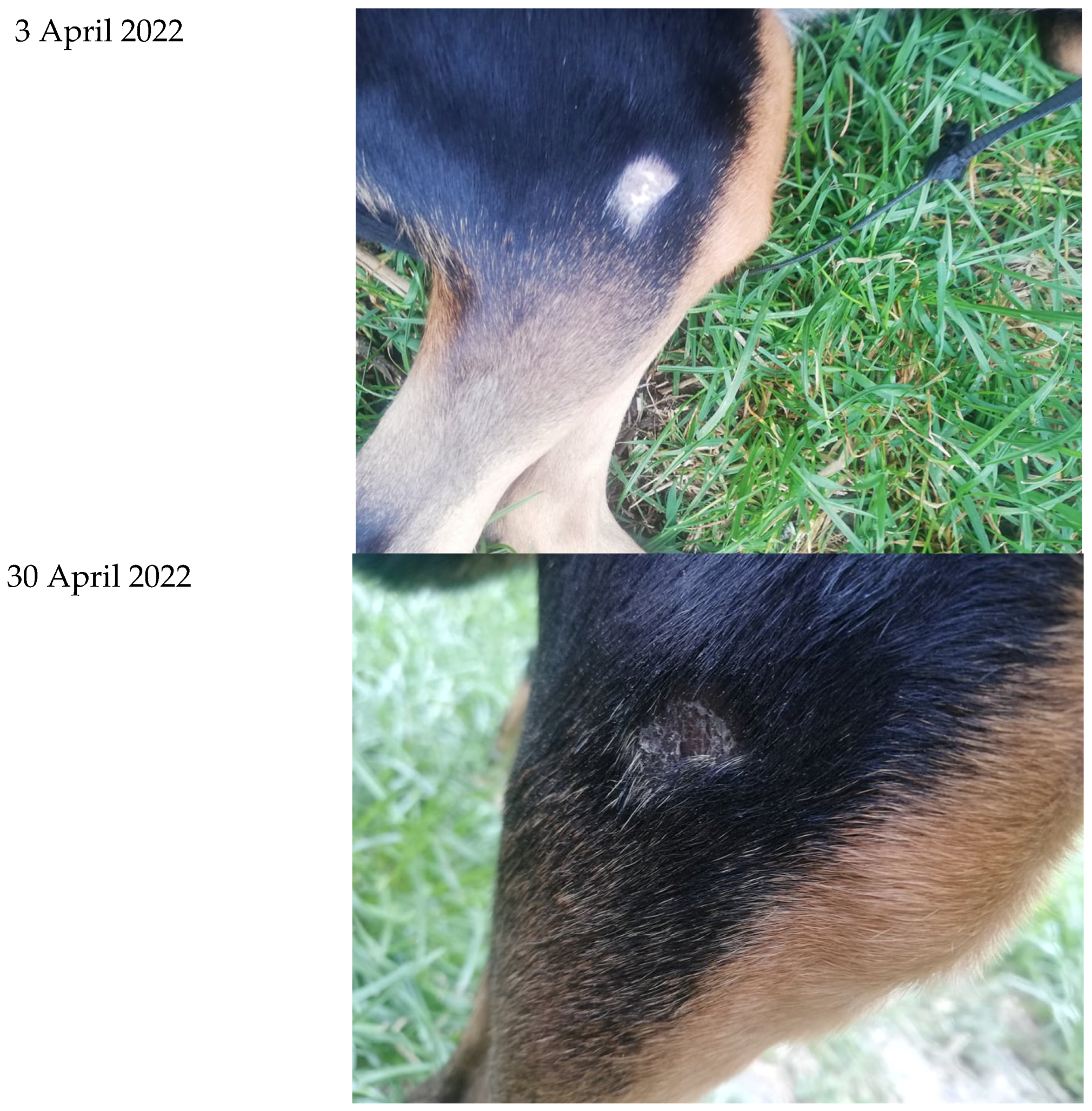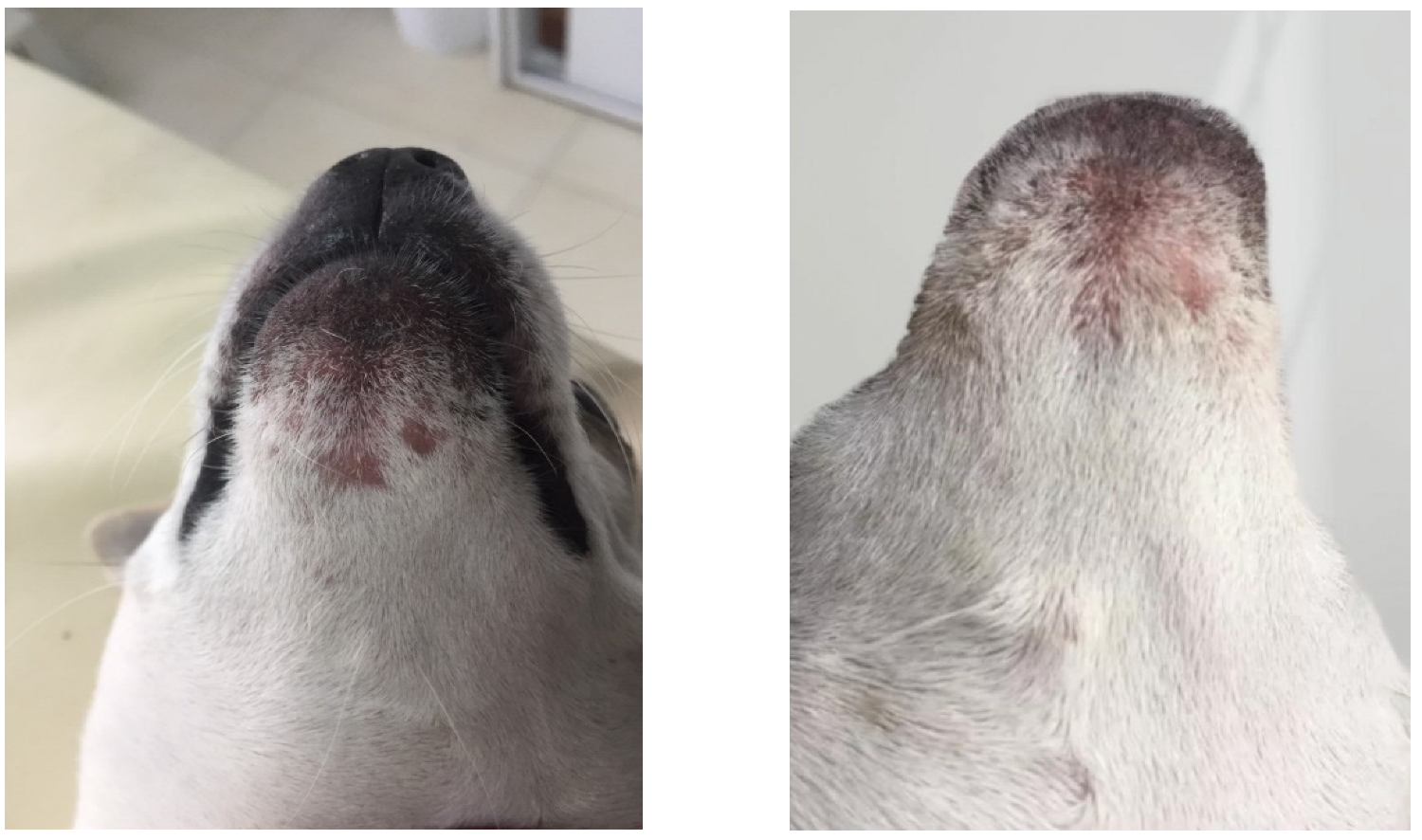Antimicrobial Activity In Vitro of Cream from Plant Extracts and Nanosilver, and Clinical Research In Vivo on Veterinary Clinical Cases
Abstract
1. Introduction
2. Materials and Methods
Determination of the Time of Antimicrobial Action of SS® Cream and Colloidal Nanosilver
- A suspension of each of the tested microbial strains with a concentration of 105 cells·mL−1 in an amount of 0.1 mL was added to 0.9 mL of SS® cream, as well as to 0.9 mL of sterile water as a control of the microbial growth, where the final concentrations became 104 cells·mL−1.
- A suspension of each of the tested microbial strains with a concentration of 107 cells·mL−1 in an amount of 0.1 mL was added to 0.9 mL of SS® cream, as well as to 0.9 mL of sterile water as a control of the microbial growth, where the final concentrations became 106 cells·mL−1.
- The following controls were applied—sterile distilled water (without SS® cream) with the same content of each of the studied microbial strains, as well as SS® cream without microorganisms.
3. Results
4. Discussion
5. Conclusions
Author Contributions
Funding
Institutional Review Board Statement
Informed Consent Statement
Data Availability Statement
Conflicts of Interest
References
- Escárcega-González, C.E.; Garza-Cervantes, J.A.; Vázquez-Rodríguez, A.; Montelongo-Peralta, L.Z.; Treviño-González, M.T.; Díaz Barriga Castro, E.; Saucedo-Salazar, E.M.; Chávez Morales, R.M.; Regalado Soto, D.I.; Treviño González, F.M.; et al. In vivo antimicrobial activity of silver nanoparticles produced via a green chemistry synthesis using Acacia rigidula as a reducing and capping agent. Int. J. Nanomed. 2018, 3, 2349–2363. [Google Scholar] [CrossRef] [PubMed]
- Popova, T.P. Examination of effect of electrochemically activated water solutions on Candida albicans after different periods of storage. J. Adv. Agric. 2019, 10, 1886–1894. [Google Scholar] [CrossRef]
- Popova, T.P.; Petrova, T.I.; Ignatov, I.; Karadzhov, S.; Dinkov, G. Antibacterial Activity of the Original Dietary Supplement Oxidal® in vitro. J. Adv. Agric. 2020, 11, 71–78. [Google Scholar] [CrossRef]
- Loo, Y.Y.; Rukayadi, Y.; Nor-Khaizura, M.-A.-R.; Kuan, C.H.; Chieng, B.W.; Nishibuchi, M.; Radu, S. In Vitro antimicrobial activity of green synthesized silver nanoparticles against selected Gram-negative foodborne pathogens. Front. Microbiol. 2018, 9, 1555. [Google Scholar] [CrossRef]
- Lara, H.H.; Ayala-Nunez, N.V.; Turent, L.C.I.; Padilla, C.R. Bactericidal effect of silver nanoparticles against multidrug-resistant bacteria. World J. Microbiol. Biotechnol. 2010, 26, 615–621. [Google Scholar] [CrossRef]
- Popova, T.P.; Ignatov, I. In vitro antimicrobial activity of colloidal nanosilver. Bulg. J. Vet. Med. 2021, 1–14. [Google Scholar] [CrossRef]
- Popova, T.P.; Ignatov, I.; Huether, F.; Petrova, T. Antimicrobial activity of colloidal nanosilver 24 ppm in vitro. Bulg. Chem. Commun. 2021, 53, 365–370. [Google Scholar] [CrossRef]
- Hussein, M.; Raja, N.I.; Igbul, M.; Aslam, S. Applications of plant flavonoids in the green Synthesis of colloidal silver nanoparticles and impacts on human health. Iran. J. Sci. Technol. Trans. A Sci. 2019, 43, 1381–1392. [Google Scholar] [CrossRef]
- Jeremiah, S.; Miyakawa, K.; Morita, T.; Yamaoka, Y.; Ryo, A. Potent antiviral effect of silver nanoparticles on SARS-CoV. Biochem. Biophys. Res. Commun. 2020, 533, 195–200. [Google Scholar] [CrossRef]
- Alsalhi, M.S.; Devanesan, S.; Alfuraydi, A.A.; Vishnubalaji, R.; Munusamy, M.A.; Murugan, K.; Nicoletti, M.; Benelli, G. Green synthesis of silver nanoparticles using Pimpinella anisum seeds: Antimicrobial activity and cytotoxicity on human neonatal skin stromal cells and colon cancer cells. Int. J. Nanomed. 2016, 11, 4439–4449. [Google Scholar] [CrossRef]
- Ignatov, I.; Popova, T.P.; Bankova, R.; Neshev, N. Spectral analyses of fresh and dry Hypericum perforatum L. Effects with Colloidal Nano Silver 30 ppm. Plant Sci. Today 2022, 9, 41–47. [Google Scholar] [CrossRef]
- Chen, X.; Schlusener, H.J. Nanosilver: A nanoproduct in medical application. Toxicol. Lett. 2008, 1, 1–12. [Google Scholar] [CrossRef] [PubMed]
- Scientific Committee on Consumer Safety. Opinion on Colloidal Silver (nao); SCCS/1596/18; European Union: Brussel, Belgium, 2018. [Google Scholar]
- De Matteis, V. Exposure to inorganic nanoparticles: Routes of entry, immune response, biodistribution and in vitro/in vivo toxicity evaluation. Toxics 2017, 5, 29. [Google Scholar] [CrossRef] [PubMed]
- Ray, A.; Nath, D. Dose dependent intra-testicular accumulation of silver nanoparticles triggers morphometric changes in seminiferous tubules and Leydig cells and changes the structural integrity of spermatozoa chromatin. Theriogenology 2022, 192, 122–131. [Google Scholar] [CrossRef]
- Kowalczyk, P.; Szymczak, M.; Maciejewska, M.; Laskowski, Ł.; Laskowska, M.; Ostaszewski, R.; Skiba, G.; Franiak-Pietryga, I. All That Glitters Is Not Silver—A New Look at Microbiological and Medical Applications of Silver Nanoparticles. Int. J. Mol. Sci. 2021, 22, 854. [Google Scholar] [CrossRef]
- Popova, T.P.; Ignatov, I. Antimicrobial activity in vitro of extracts from the combinations of African Geranium, Black Elderberry and St. John’s Wort in colloidal nano silver. Plant Cell Biotechnol. Mol. Biol. 2021, 22, 272–285. [Google Scholar]
- Mathur, P.; Jha, S.; Ramteke, S.; Jain, N.K. Pharmaceutical aspects of silver nanoparticles. Artificial Cells. Nanomed. Biotechnol. 2018, 46 (Suppl. 1), 115–126. [Google Scholar] [CrossRef]
- Zahoor, M.; Nazir, N. A Review on Silver Nanoparticles: Classification, Various Methods of Synthesis, and Their Potential Roles in Biomedical Applications and Water Treatment. Water 2021, 13, 2216. [Google Scholar] [CrossRef]
- Popova, T.P.; Kaleva, M.D. Antimicrobial effect in vitro of aqueous extracts of leaves and branches of willow (Salix babylonica L.). Int. J. Curr. Microbiol. Appl. Sci. 2015, 4, 146–152. [Google Scholar]
- Bankova, R.; Popova, T.P. Antimicrobial activity in vitro of aqueous extracts of oregano (Origanum vulgare L.) and thyme (Thymus vulgaris L.). Int. J. Curr. Microbiol. Appl. Sci. 2017, 6, 1–12. [Google Scholar] [CrossRef]
- Ignatov, I.; Popova, T.P.; Yaneva, I.; Balabanski, V.; Baiti, S.; Angelcheva, M.; Angushev, I. Spectral analysis of Sambucus nigra L. fruits and flowers for elucidation of their analgesic, diuretic, anti-inflammatory and anti-tumor effects. Plant Cell Biotechnol. Mol. Biol. 2021, 22, 134–140. [Google Scholar]
- Przybylska-Balcerek, A.; Szablewski, T.; Szwajkowska-Michałek, L.; Świerk, D.; Cegielska-Radziejewska, R.; Krejpcio, Z.; Suchowilska, E.; Tomczyk, Ł.; Stuper-Szablewska, K. Sambucus Nigra Extracts–Natural Antioxidants and Antimicrobial Compounds. Molecules 2021, 26, 2910. [Google Scholar] [CrossRef] [PubMed]
- Moyo, M.; Van Staden, J. Medicinal properties and conservation of Pelargonium sidoides DC. J. Ethnopharmacol. 2014, 152, 243–255. [Google Scholar] [CrossRef] [PubMed]
- Wölfle, U.G.; Seelinger, C.; Schempp, M. Topical application of St. John’s Wort (Hypericum perforatum). Planta Med. 2014, 80, 109–120. [Google Scholar] [CrossRef]
- Milutinović, M.; Miladinović, M.; Gašić, U.; Brankovic, D.S.; Stojanovic, M.R. Recovery of bioactive molecules from Hypericum perforatum L. dust using microwave-assisted extraction. Biomass Conv. Bioref. 2022, 1–13. [Google Scholar] [CrossRef]
- Disler, M.; Ivemeyer, S.S.; Hamburger, M.; Vogl, C.R.; Tesic, A.; Klarer, F.; Walkenhorst, M.M. Ethnoveterinary herbal remedies used by farmers in four north-eastern Swiss cantons (St. Gallen, Thurgau, Appenzell Innerrhoden and Appenzell Ausserrhoden). J. Ethnobiol. Ethnomed. 2014, 10, 32. [Google Scholar] [CrossRef]
- Baiti, S. Silver Stop. Patent FR2106735, 24 June 2021. [Google Scholar]
- BDS 1550-85; Herbs (Herbal Drugs). Technical Requirements, Standardization. Bulgarian Institute for Standardization: Sofia, Bulgaria, 2016. Available online: https://bds-bg.org/en/project/show/bds:proj:19747 (accessed on 11 April 2016).
- Control Device and Method for Driving Electrodes of at Least One Electrolysis Device for Electrochemical Production of Nanoparticles. Patent PCT/EP2021/054691, 25 February 2021.
- Bauer, A.W.; Kirby, W.M.; Cherris, J.C.; Truck, M. Antibiotic susceptibility testing by a standardized single disk method. Am. J. Clin. Pathol. 1966, 45, 493–496. [Google Scholar] [CrossRef]
- National Committee for Clinical Laboratory Standards. Performance Standards for Antimicrobial Disk Susceptibility Tests, 6th ed.; Approved Standard; Clinical and Laboratory Standards Institute: Wayne, PA, USA, 1997; Volume 17, p. 1. [Google Scholar]
- National Committee for Clinical Laboratory Standards. Performance Standards for Antimicrobial Susceptibility Testing: Ninths Informational Supplement; NCCLS Document M100–S9; Clinical and Laboratory Standards Institute: Wayne, PA, USA, 1999; Volume 18, p. 1. [Google Scholar]
- Mosin, O.V.; Ignatov, I. Preparation of nanoparticles of colloid silver and spheres of their practical using. Nanoengeneering 2013, 5, 23–30. [Google Scholar]
- Kolodziej, H. Antimicrobial, antiviral and immunomodulatory activity studies of Pelargonium sidoides (EPs® 7630) in the context of health promotion. Pharmaceuticals 2011, 4, 1295–1314. [Google Scholar] [CrossRef]
- Mativandlela, S.P.N.; Lall, N.; Meyer, J.J.M. Antibacterial, antifungal and antitubercular activity of (the roots of) Pelargonium reniforme (CURT) and Pelargonium sidoides (DC) (Geraniaceae) root extracts. S. Afr. J. Bot. 2006, 72, 232–237. [Google Scholar] [CrossRef]
- Jonušaite, K.; Venskutonis, P.R.; Martínez-Hernández, G.B.; Taboada-Rodríguez, A.; Nieto, G.; López-Gómez, A.; Marín-Iniesta, F. Antioxidant and antimicrobial effect of plant essential oils and Sambucus nigra extract in salmon burgers. Foods 2021, 10, 776. [Google Scholar] [CrossRef] [PubMed]
- Álvarez, C.A.; Barriga, A.; Albericio, F.; Romero, M.S.; Guzmán, F. Identification of peptides in flowers of Sambucus nigra with antimicrobial activity against aquaculture pathogens. Molecules 2018, 23, 1033. [Google Scholar] [CrossRef] [PubMed]
- Süntar, I.; Oyardı, O.; Akkol, E.K.; Ozçelik, B. Antimicrobial effect of the extracts from Hypericum perforatum against oral bacteria and biofilm formation. Pharm. Biol. 2016, 54, 1065–1070. [Google Scholar] [CrossRef]
- Nazlı, O.; Baygar, T.; Dönmez, Ç.E.D.; Dere, Ö.A.; Uysal, İ.; Aksözek, A.; Işık, C.; Aktürk, S. Antimicrobial and antibiofilm activity of polyurethane/Hypericum perforatum extract (PHPE) composite. Bioorg. Chem. 2019, 82, 224–228. [Google Scholar] [CrossRef] [PubMed]




| Microorganisms | No of Strains | Inhibitory Zones in mm | |
|---|---|---|---|
| SS® Cream | Thiamphenicol | ||
| E. coli | 3 | 19.0 ± 2.0 | 26.3 ± 4.9 |
| S. aureus | 3 | 15.6 ± 1.6 | 25.0 ± 1.4 |
| C. albicans | 3 | 15.3 ± 0.4 | 23.7 ± 4.0 |
| Microorganisms | Growth of the Strains (Percent of Colony Number in Comparison with the Untreated Controls) after Different Intervals of Exposure | ||||||
|---|---|---|---|---|---|---|---|
| 1 min | 5 min | 10 min | 20 min | 40 min | 60 min | 2 h | |
| Escherichia coli | 0 | 0 | 0 | 0 | 0 | 0 | 0 |
| Staphylococcus aureus | 74.3 ± 4.2 | 56.0 ± 4.3 | 35.0 ± 4.1 | 19.7 ± 6.1 | 3.8 ± 0.1 | 0 | 0 |
| Candida albicans | 79.0 ± 2.9 | 49.3 ± 2.5 | 0 | 0 | 0 | 0 | 0 |
| Untreated controls | 100.0 | 100.0 | 100.0 | 100.0 | 100.0 | 100.0 | 100.0 |
| Microorganisms | Growth of the Strains (Percent of Colony Number in Comparison with the Untreated Controls) after Different Intervals of Exposure | ||||||
|---|---|---|---|---|---|---|---|
| 1 min | 5 min | 10 min | 20 min | 40 min | 60 min | 120 min | |
| Escherichia coli | 19.3 ± 6.7 | 6.0 ± 4.3 | 0 | 0 | 0 | 0 | 0 |
| Staphylococcus aureus | 88.0 ± 1.6 | 82.3 ± 2.1 | 72.3 ± 2.1 | 62.7 ± 3.8 | 53.3 ± 4.7 | 26.7 ± 12.5 | 7.7 ± 2.1 |
| Candida albicans | 85.7 ± 3.3 | 73.3 ± 2.5 | 60.3 ± 3.7 | 39.0 ± 2.9 | 20.7 ± 2.5 | 0 | 0 |
| Untreated controls | 100.0 | 100.0 | 100.0 | 100.0 | 100.0 | 100.0 | 100.0 |
Publisher’s Note: MDPI stays neutral with regard to jurisdictional claims in published maps and institutional affiliations. |
© 2022 by the authors. Licensee MDPI, Basel, Switzerland. This article is an open access article distributed under the terms and conditions of the Creative Commons Attribution (CC BY) license (https://creativecommons.org/licenses/by/4.0/).
Share and Cite
Popova, T.P.; Ignatov, I.; Petrova, T.E.; Kaleva, M.D.; Huether, F.; Karadzhov, S.D. Antimicrobial Activity In Vitro of Cream from Plant Extracts and Nanosilver, and Clinical Research In Vivo on Veterinary Clinical Cases. Cosmetics 2022, 9, 122. https://doi.org/10.3390/cosmetics9060122
Popova TP, Ignatov I, Petrova TE, Kaleva MD, Huether F, Karadzhov SD. Antimicrobial Activity In Vitro of Cream from Plant Extracts and Nanosilver, and Clinical Research In Vivo on Veterinary Clinical Cases. Cosmetics. 2022; 9(6):122. https://doi.org/10.3390/cosmetics9060122
Chicago/Turabian StylePopova, Teodora P., Ignat Ignatov, Toshka E. Petrova, Mila D. Kaleva, Fabio Huether, and Stoil D. Karadzhov. 2022. "Antimicrobial Activity In Vitro of Cream from Plant Extracts and Nanosilver, and Clinical Research In Vivo on Veterinary Clinical Cases" Cosmetics 9, no. 6: 122. https://doi.org/10.3390/cosmetics9060122
APA StylePopova, T. P., Ignatov, I., Petrova, T. E., Kaleva, M. D., Huether, F., & Karadzhov, S. D. (2022). Antimicrobial Activity In Vitro of Cream from Plant Extracts and Nanosilver, and Clinical Research In Vivo on Veterinary Clinical Cases. Cosmetics, 9(6), 122. https://doi.org/10.3390/cosmetics9060122








